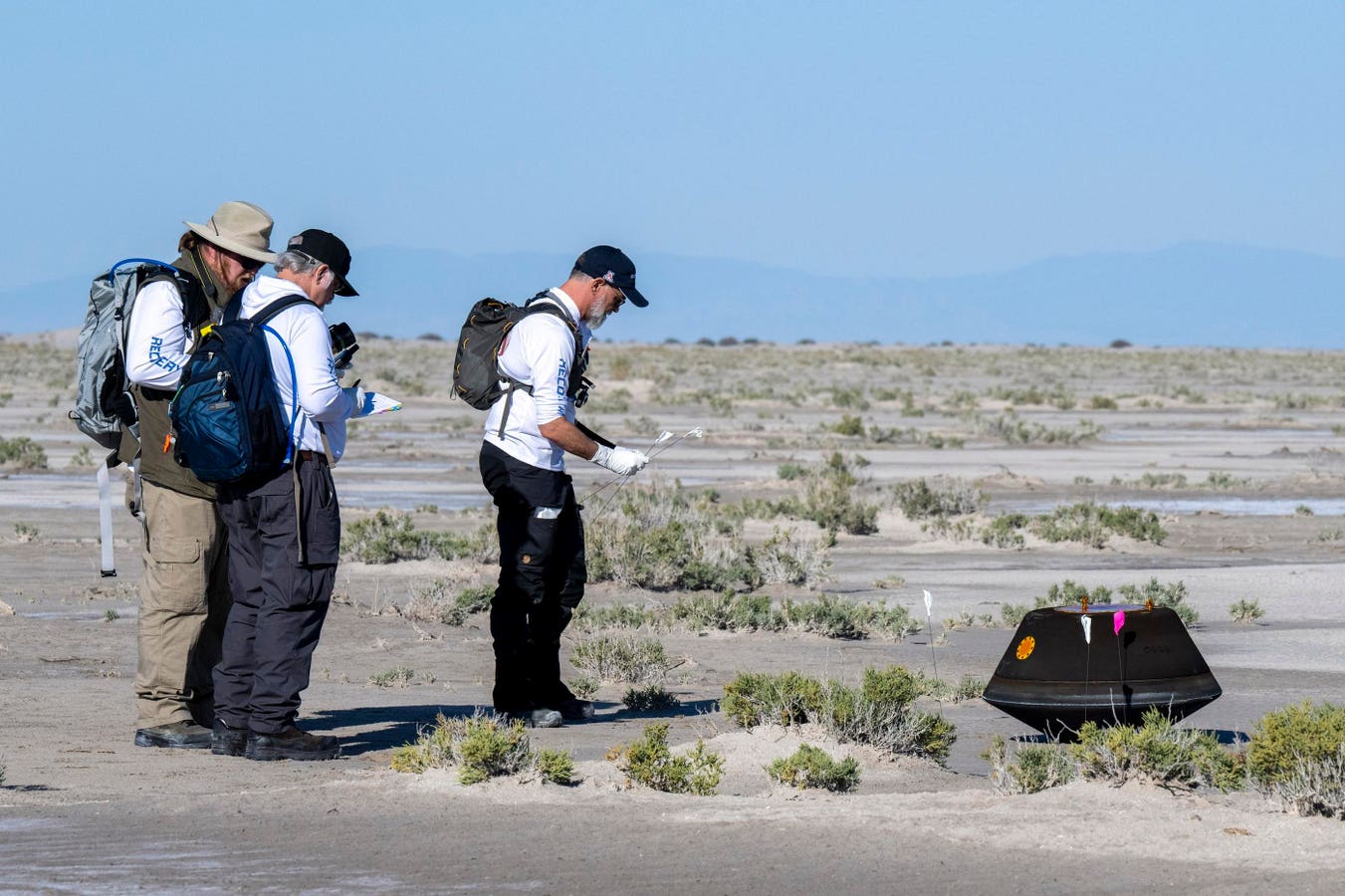DUGWAY, UTAH – September 24: In this NASA-provided flyer, from left to right, NASA … [+]
It is humbling to realize that we are the first sentient beings to successfully taste Bennu, a 500 meter asteroid that has been around even longer than planet Earth. Samples from carbon-rich Bennu are already providing new clues about the ubiquity and diversity of chemical compounds in our early solar system.
But a page-turning new book offers an inside look at how such missions are done.
in Asteroid Hunter: A Scientist’s Journey to the Dawn of Our Solar SystemDante Lauretta deftly chronicles his journey from college-age cook to order to one of the chief architects of a space mission that represents one of the signal scientific achievements of the 21st century.Holy century.
The history of the mission dates back to a casual meeting over drinks with a Lockheed Martin executive, the director of the University of Arizona’s Lunar and Planetary Laboratory, and Lauretta in a posh Tucson hotel bar. In just a few minutes, Lauretta roughed up the basic concepts of what would become OSIRIS-REx (Origins, Spectral Interpretation, Resource Identification, Security-Regolith Explorer).
In the two short decades since that first encounter at a cocktail bar, OSIRIS-REx has successfully returned a 4.5-billion-year-old sample from Bennu and delivered it safely to the Utah desert. There, Lauretta and colleagues eagerly awaited the return of the pristine specimen.
What did the mission teach us about Bennu?
Bennu is a fragment of a much larger object that broke up in the main asteroid belt on the order of a billion years ago, Lauretta, OSIRIS-REx principal investigator and astrobiologist at the University of Arizona in Tucson, told me by phone. . This object was about 200 km in diameter and formed much further out in the solar system, probably around where Saturn is right now, he says. All the basic building blocks of life are found in this object, Lauretta says, and its parent was probably either an ocean world or a mud world very early in the solar system’s history.
Ancient clay mud
Bennu’s parent asteroid must have been a giant convective ball of mud, circulating fluid for millions of years and completely altering the original mineralogy, writes Lauretta Asteroid Hunter.
Bennu probably broke off from a much larger, carbon-rich asteroid about 700 million to 2 billion years ago, NASA says.
A low density object
Most asteroids in the inner solar system are rocky, high-density near-Earth objects, Lauretta says. But Bennu is much more porous and much less dense than we ever expected, he says.
Why are asteroids so important to understanding life in the solar system?
If you start trying to piece together the history of our planet, you get to a point about 4 billion years ago where there is no rock record left, Lauretta says. You have to go to the asteroids to understand all the way back to the very beginnings of minerals and organic matter and ice formation in our solar system, he says. It holds the earliest stages of solar system development, he notes.
Robust surface
Bennu’s surface was much more rugged and rocky than predicted from our analysis of the telescope data, Lauretta says. We thought it would be sandy, or maybe gravel, and it was dominated by these giant boulders, he says.
Sample surprise
After analysis, the phosphates found on Bennu appear to have evaporated from an ancient oceanic world, sort of like the icy satellites we see around Saturn, Lauretta says. And we’re really excited about the variety of organic material, he says.
Why is phosphorus so important to life?
The two rails that make up the double helix structure of DNA are phosphates attached to sugars, Lauretta explains. Thus, phosphate is essential in the formation of DNA and RNA, he notes. It’s also a really important element for an energy-carrying molecule called adenosine triphosphate (ATP), Lauretta says, because the P stands for phosphate. And once you get to animals like us, phosphate minerals also make up our bones and teeth, he says.
By mass, phosphorus is the fifth most important biological element after hydrogen, carbon, oxygen and nitrogen, Lauretta writes in her book. But where terrestrial life got its phosphorus is a mystery, he writes.
Asteroid Hunter
Abundance of Amino Acids
In our samples, we found 13 of the 20 amino acids that are used in biology, says Lauretta.
As for the other seven?
We can’t rule them out yet, maybe they were below our current detection limit, says Lauretta. We also found all four nucleobases, or letters of the genetic code used in DNA; that means Earth received these compounds from these carbon-rich asteroids, he says.
The samples might even reveal some kind of microfossils or evidence of past life, if they are there.
That’s something we pay a lot of attention to, says Lauretta, but there’s something fundamental we’re missing in understanding the origins of life. In particular, he wonders what happens when mere geological material becomes something that is alive. Lauretta is also confused as to why molecules self-organize into living organisms with instincts for protection and the ability to respond to their environment.
As for OSIRIS-REx?
About 20 minutes after the OSIRIS-REx spacecraft launched its sample reentry capsule into Earth’s atmosphere, the spacecraft fired its engines and set off on a new mission, NASA says. The spacecraft, newly named OSIRIS-Apophis Explorer, is scheduled to reach asteroid Apophis in 2029.
